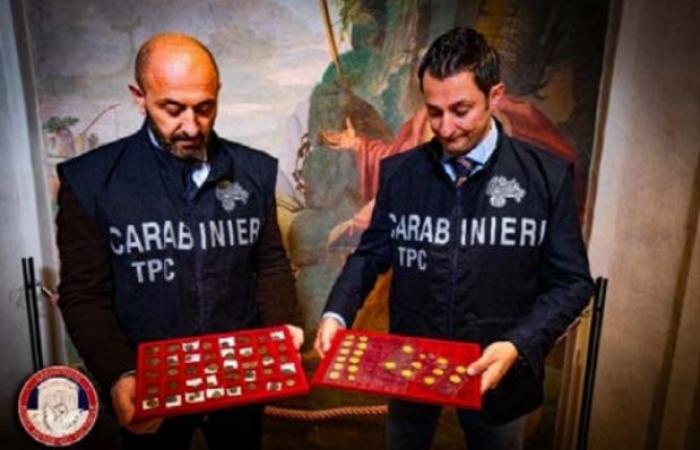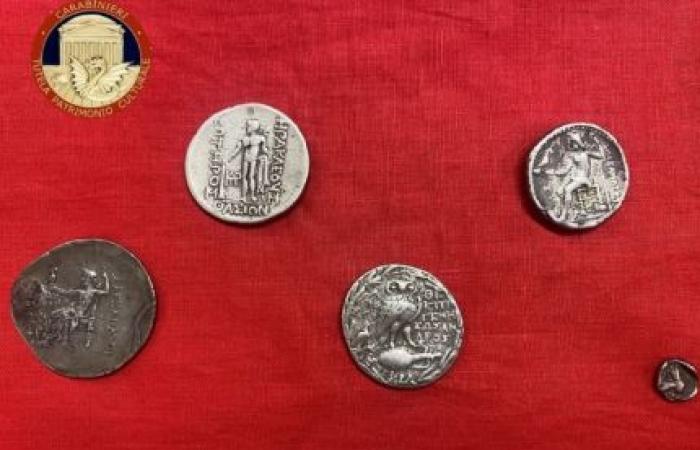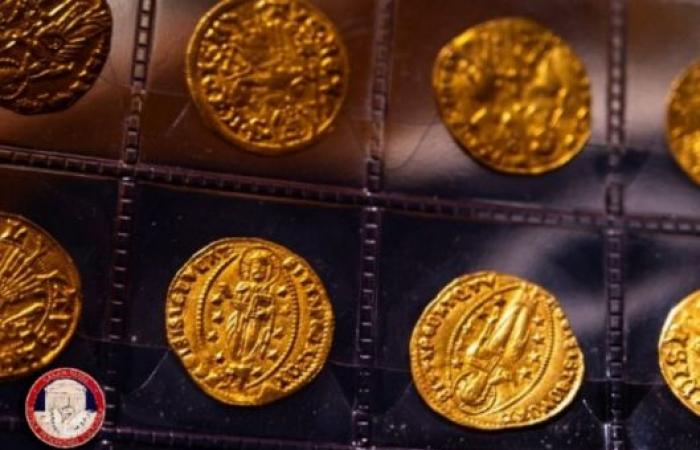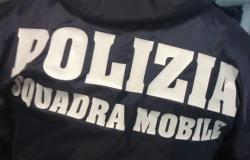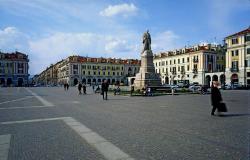A 2023 of intense activity for the Carabinieri Cultural Heritage Protection Unit (TPC) of Monza. This can be seen from the numbers first of all: in the past year, as part of the multiple investigative activities, the Carabinieri reported 74 people in a state of freedom, including 37 for receiving stolen goods, 6 for theft, 3 for clandestine excavation, 5 for damage, 1 for illicit export of cultural goods, 15 for crimes against the landscape, 4 for criminal association and 16 for
counterfeiting of works of art. Not only that, the military managed to seize 15,923 antiquarian, archival and book assets as well as 555 archaeological assets and 590 paleontological finds.
All the 2023 issues of the Carabinieri Unit for the Protection of Cultural Heritage
Lombardy, the region under the responsibility of the Monza Unit, is rich in art and culture and over the past year has seen the TPC carabinieri employed not only in repressive activities, but also and above all in preventive activities with 25 inspections for the assessment of the safety status of museums/libraries/archives, 37 archaeological areas; 142 checks on areas protected by landscape/monumental restrictions and over 211 on antique and commercial businesses.
All this is thanks undisputedly to the commitment and professionalism of the specialized personnel, but also to the close collaboration with the departments of the Territorial Army and other Special Departments, the officials of the Superintendencies, the Dioceses as well as with private individuals, archives and artists’ foundations.
A control activity of the market, of commercial, fixed and itinerant activities and of the now widespread constant online market; an activity which saw over 2317 cultural assets subjected to photographic verification through comparison with the information contained in the LEONARDO database, the largest database of illicitly stolen cultural assets in the world and a fundamental investigative tool for the protection of our immense cultural heritage.
Meetings with students and citizens
The staff of the TPC Unit of Monza also participated in 18 meetings with students from Lombardy schools as part of the Carabinieri’s contributions to the formation of the “Culture of legality”, precisely to disseminate and underline the importance of the protection of property cultural and landscape as they express our identity. With the same purpose, staff from the Monza Unit participated in two meetings held respectively at the Accademia Carrara in Bergamo and the Santa Giulia Museum in Brescia, as part of the initiatives connected to the “Bergamo Brescia Capital of Culture 2023” event. meeting numerous citizens to whom the institutional tasks and activities promoted by the Carabinieri Cultural Heritage Protection Command were illustrated.
In addition to the commitment in the national territory, there have been many interventions abroad conducted by personnel of the Unit in order to increase awareness on the protection and prevention of damage to the historical-cultural heritage. Among the many, we highlight the project held in Jordan, developed within the European twinning “Supporting the Royal Department for Environment Protection and Tourism in enforcing environmental and tourism laws effectively in Jordan”, the project held in Lebanon called “Protect Heritage” – Project to Support Operations in Lebanon on Cultural Heritage and the project held in Mexico, relating to technical assistance in the field of terrorist financing and money laundering.
The Monza Unit also participated through the “Blue Helmets of Culture” task force in the recovery and safety activities of countless book and archival assets put at risk by the calamitous events that affected the Emilia Romagna region in the spring of last year. year.
The most significant activities of the year
Among the most significant events of 2023 we note the return to the Parish of San Bernardo di Lainate (MI), Barbaiana district, of the painting created with the oil on canvas technique by an unknown author, dating back to the 18th century and depicting the mourning of Christ dead, which had been stolen more than twenty years ago from a side transept of the Church. This result was possible thanks to the daily checks of the e-commerce sites and major auction houses by the staff of the TPC Unit of Monza who, once the work had been identified and thanks to the consultation of the Data Bank of Illicitly Stolen Cultural Heritage of the Carabinieri Cultural Heritage Protection Command, compared it with the images present in it, discovering that the Lamentation was precisely the one that was the object of the theft reported on the morning of March 27, 2001.
And also the return to the hands of the Greek Ambassador to Italy, HE Eleni Sourani, of five coins dating back to between the 5th and 1st century BC from Ancient Greece, which had been identified by the Carabinieri of the TPC Unit of Monza during the checks of e-commerce sites. The coins constitute a direct and tangible testimony of the art, culture and economy of the ancient Greek world, in a chronological span that covers both the “classical” period (5th century AD) and the Hellenistic period (4th – 2nd century BC) and which sees the creation and then the diffusion of artistic and cultural models that have profoundly influenced the entire Mediterranean basin and all of Europe up to the present day. The ancient coins returned today by the Carabinieri of the TPC Unit of Monza to the Embassy of Greece in Italy provide precious information on the history, politics and culture of past civilizations, but also on technology, art, religion, trade and economic relations between different regions.
These small coins, of great historical value, were put up for sale in a single advertisement which proposed the purchase of the entire lot for the sum of 1,500 euros, triggering investigations by the Carabinieri – part of an of contrasting the clandestine market of archaeological material – coordinated by the Milanese Judicial Authority, which then allowed the seizure of the coins considered to be of an archaeological nature and of Greek origin by the officials of the Superintendence of Milan.
Among the most important activities of the year 2023 there is also the return to the State, through SABAP Cremona, Lodi and Mantua of over a thousand archaeological finds and other cultural assets: ceramic and lead artefacts, fibulae, keys , brooches and rings, but also bow stringers and apotropaic pendants, which can be framed in a broad chronological horizon that goes from the protohistoric age (5th century BC) to the Roman age up to the 20th century.
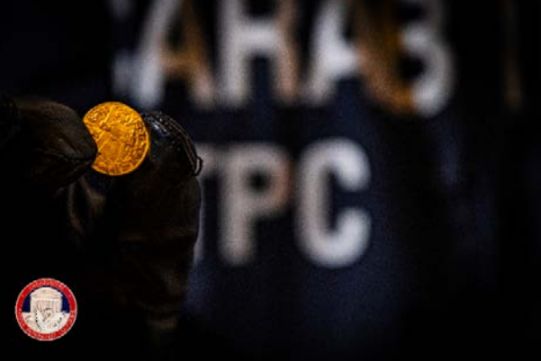
Photo 1 of 2
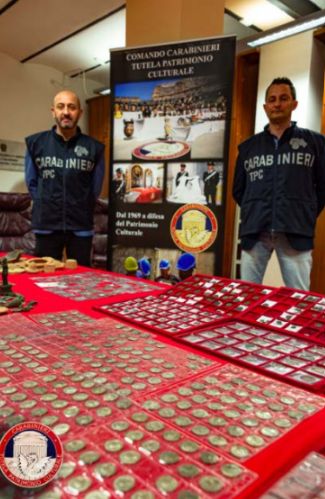
Photo 2 of 2
The Carabinieri of the Unit for the Protection of Cultural Heritage of Monza, coordinated by the Judicial Authority of Mantua and in collaboration with the archaeological officials of the Superintendence of Archaeology, Fine Arts and Landscape for the provinces of Cremona, Lodi and Mantua, as part of the activities controls at markets and antique fairs had seized tools and various material for research and excavations as well as numerous metal weights of various sizes: metal muzzle-loading balls, around 200 bronze and metal objects of different shapes and sizes, some small bronzes, fragments and terracotta vases. The investigation activity also made it possible to seize around 600 coins in various metallic creations (gold, silver and non-noble alloys) and in an excellent state of conservation, dating back to different chronologies that cover the first forms of coinage known in the Po Valley area ( 6th-5th century BC) until the 19th century with some Roman, late ancient and medieval nuclei. In fact, everything was the result of excavation and research activities conducted by an elderly citizen of the province of Mantua who, for this reason, was handed over in a state of freedom to the Judicial Authority for receiving stolen goods and illicit possession of cultural assets belonging to the State.
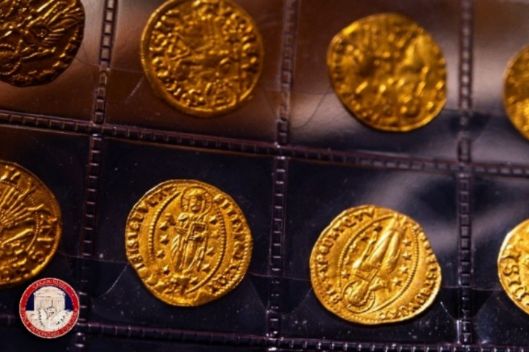
Photo 1 of 2

Photo 2 of 2
Also in 2023 there was the return of a gargoyle to the Milan Cathedral, better known by the name of gargoyle. Gargoyles represent creatures of various shapes and characteristics and are architectural elements used in Gothic cathedrals and created to convey rainwater in the absence of downspouts, thus moving the water away from the cathedral itself.
The seized gargoyle depicts a winged dragon, belonging to the monumental complex of the Cathedral, a piece that fell from one of the spiers of the Milan Cathedral in
following the bombings that damaged the cathedral, and not only, in 1943. The cultural asset was found to be of criminal origin because it was sold, in violation of the provisions of the legislation on the alienation of cultural assets, by a Milanese art gallery whose representative had illicitly exported the goods abroad by presenting them to an export office to obtain the free circulation certificate, issuing untruthful declarations and above all stating that the gargoyle was not the result of a detachment and that it came from Northern Europe, despite being aware of the real nature and origin of the good itself. The investigations and investigations, conducted by the Carabinieri of the Cultural Heritage Protection Unit of Monza together with the experts of the Veneranda Fabbrica del Duomo and coordinated by the Judicial Authority of Milan, made it possible to trace the gargoyle to a restorer in the Netherlands where, once completed the restoration would then have to go on display for sale at an antiques fair.
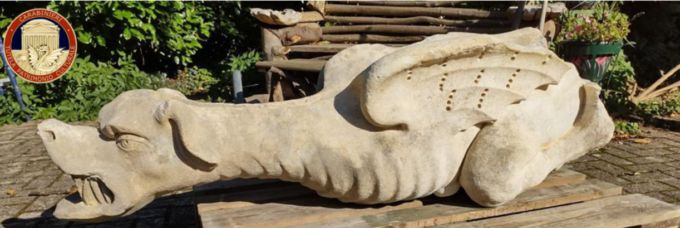
In fact, also through the execution of a European investigation order and the consequent issuing of the freezing certificate for execution in the countries
of the European Union for the subsequent confiscation of the cultural property and its return to the rightful owner, with the coordination of EUROJUST, the collateral body of the Dutch National Police collaborated in the reconstruction of the journey that the gargoyle had made to Europe starting from Italy and then arrived in Belgium after a short stop in Holland.
The activity of the Carabinieri of the TPC of Monza also made it possible to retrace the transfers that took place from the Second World War onwards up to the present day, establishing that the owner of the property right on the gargoyle was still the Veneranda Fabbrica del Duomo, a to whom the winged dragon is thus returned.

